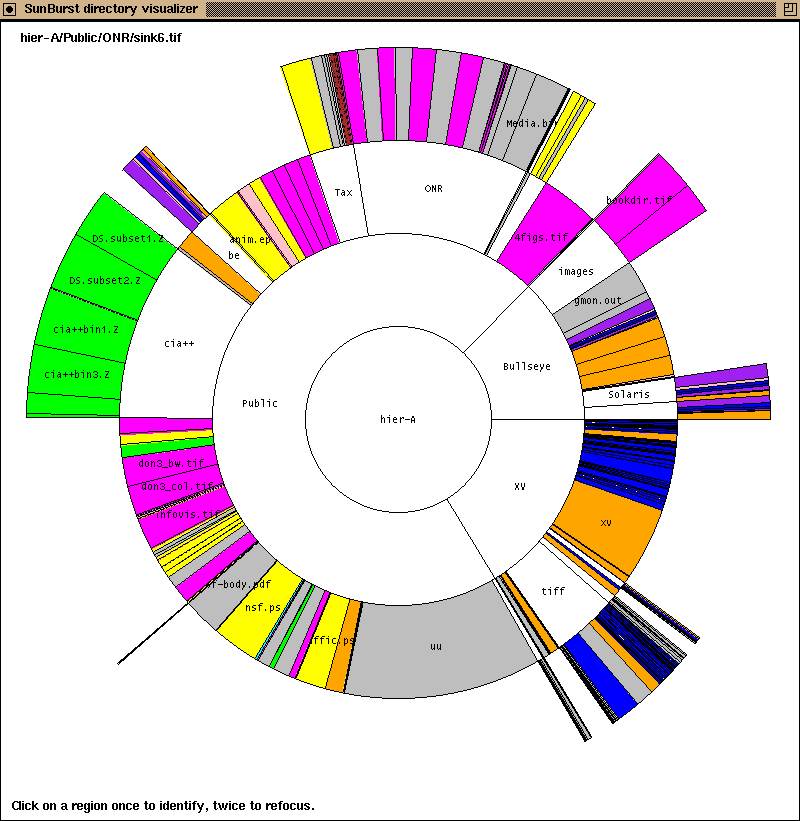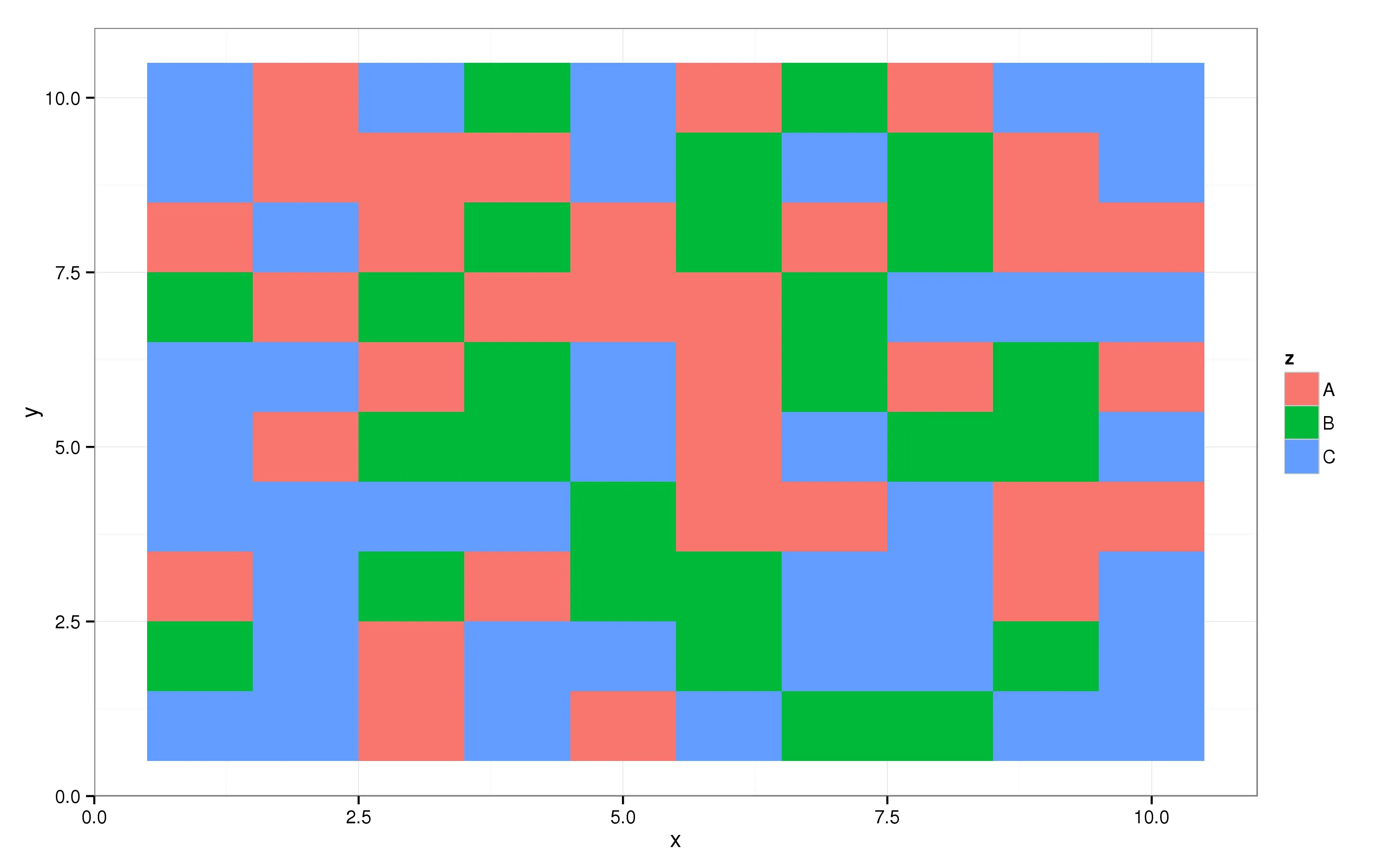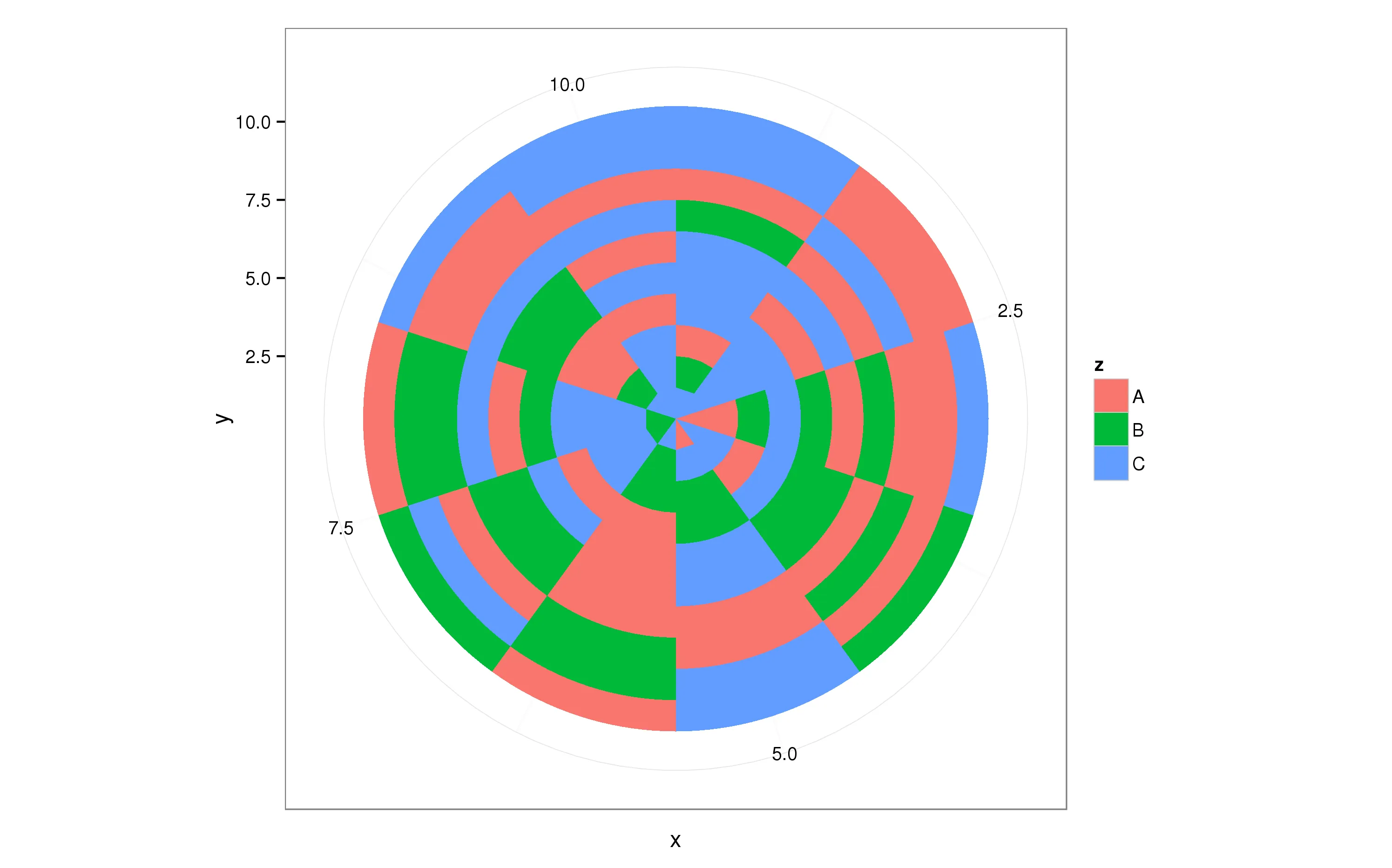到目前为止,我没有找到任何一个R库可以像John Stasko的那些旭日图一样创建旭日图。 有人知道如何在R或Python中实现吗?

到目前为止,我没有找到任何一个R库可以像John Stasko的那些旭日图一样创建旭日图。 有人知道如何在R或Python中实现吗?

使用matplotlib库在极坐标系中绘制sunburst图的Python代码:
import numpy as np
import matplotlib.pyplot as plt
def sunburst(nodes, total=np.pi * 2, offset=0, level=0, ax=None):
ax = ax or plt.subplot(111, projection='polar')
if level == 0 and len(nodes) == 1:
label, value, subnodes = nodes[0]
ax.bar([0], [0.5], [np.pi * 2])
ax.text(0, 0, label, ha='center', va='center')
sunburst(subnodes, total=value, level=level + 1, ax=ax)
elif nodes:
d = np.pi * 2 / total
labels = []
widths = []
local_offset = offset
for label, value, subnodes in nodes:
labels.append(label)
widths.append(value * d)
sunburst(subnodes, total=total, offset=local_offset,
level=level + 1, ax=ax)
local_offset += value
values = np.cumsum([offset * d] + widths[:-1])
heights = [1] * len(nodes)
bottoms = np.zeros(len(nodes)) + level - 0.5
rects = ax.bar(values, heights, widths, bottoms, linewidth=1,
edgecolor='white', align='edge')
for rect, label in zip(rects, labels):
x = rect.get_x() + rect.get_width() / 2
y = rect.get_y() + rect.get_height() / 2
rotation = (90 + (360 - np.degrees(x) % 180)) % 360
ax.text(x, y, label, rotation=rotation, ha='center', va='center')
if level == 0:
ax.set_theta_direction(-1)
ax.set_theta_zero_location('N')
ax.set_axis_off()
示例,这个函数如何使用:
data = [
('/', 100, [
('home', 70, [
('Images', 40, []),
('Videos', 20, []),
('Documents', 5, []),
]),
('usr', 15, [
('src', 6, [
('linux-headers', 4, []),
('virtualbox', 1, []),
]),
('lib', 4, []),
('share', 2, []),
('bin', 1, []),
('local', 1, []),
('include', 1, []),
]),
]),
]
sunburst(data)
现在你甚至可以很容易地使用R构建一个交互式版本:
# devtools::install_github("timelyportfolio/sunburstR")
library(sunburstR)
# read in sample visit-sequences.csv data provided in source
# https://gist.github.com/kerryrodden/7090426#file-visit-sequences-csv
sequences <- read.csv(
system.file("examples/visit-sequences.csv",package="sunburstR")
,header=F
,stringsAsFactors = FALSE
)
sunburst(sequences)
...当你将鼠标悬停在它上面时,魔法就发生了:
编辑
此软件包的官方网站可以在此处找到(有许多示例!):https://github.com/timelyportfolio/sunburstR
感谢 @timelyportfolio 创建了这个令人印象深刻的代码!
您可以使用ggplot2包中的geom_tile创建类似于太阳辐射图的东西。让我们首先创建一些随机数据:
require(ggplot2); theme_set(theme_bw())
require(plyr)
dat = data.frame(expand.grid(x = 1:10, y = 1:10),
z = sample(LETTERS[1:3], size = 100, replace = TRUE))
然后创建栅格图。 在此,图中的 x 轴与 dat 中的 x 变量相对应,y 轴与 y 变量相对应,像素的填充与 z 变量相对应。 得到以下图形:
p = ggplot(dat, aes(x = x, y = y, fill = z)) + geom_tile()
print(p)

p + coord_polar()

dat以获得所需结果。ggplot2 旭日图。library(ggplot2)
# make some fake data
df <- data.frame(
'level1'=c('a', 'a', 'a', 'a', 'b', 'b', 'c', 'c', 'c'),
'level2'=c('a1', 'a2', 'a3', 'a4', 'b1', 'b2', 'c1', 'c2', 'c3'),
'value'=c(.025, .05, .027, .005, .012, .014, .1, .03, .18))
# sunburst plot
ggplot(df, aes(y=value)) +
geom_bar(aes(fill=level1, x=0), width=.5, stat='identity') +
geom_bar(aes(fill=level2, x=.25), width=.25, stat='identity') +
coord_polar(theta='y')
与专门针对Sunburst的软件相比,唯一的缺点是它假设您希望外层是完全穷尽的(即没有空白)。部分穷尽的外层(如其他示例中的一些)肯定是可能的,但更加复杂。
为了完整起见,这里进行了清理,使用了更好的格式和标签:
library(data.table)
# compute cumulative sum for outer labels
df <- data.table(df)
df[, cumulative:=cumsum(value)-(value/2)]
# store labels for inner circle
inner_df <- df[, c('level1', 'value'), with=FALSE]
inner_df[, level1_value:=sum(value), by='level1']
inner_df <- unique(text_df[, c('level1', 'level1_value'), with=FALSE])
inner_df[, cumulative:=cumsum(level1_value)]
inner_df[, prev:=shift(cumulative)]
inner_df[is.na(prev), position:=(level1_value/2)]
inner_df[!is.na(prev), position:=(level1_value/2)+prev]
colors <- c('#6a3d9a', '#1F78B4', '#33A02C', '#3F146D', '#56238D', '#855CB1', '#AD8CD0', '#08619A', '#3F8DC0', '#076302', '#1B8416', '#50B74B')
colorNames <- c(unique(as.character(df$level1)), unique(as.character(df$level2)))
names(colors) <- colorNames
ggplot(df, aes(y=value, x='')) +
geom_bar(aes(fill=level2, x=.25), width=.25, stat='identity') +
geom_bar(aes(fill=level1, x=0), width=.5, stat='identity') +
geom_text(data=inner_df, aes(label=level1, x=.05, y=position)) +
coord_polar(theta='y') +
scale_fill_manual('', values=colors) +
theme_minimal() +
guides(fill=guide_legend(ncol=1)) +
labs(title='') +
scale_x_continuous(breaks=NULL) +
scale_y_continuous(breaks=df$cumulative, labels=df$level2, 5) +
theme(axis.title.x=element_blank(), axis.title.y=element_blank(), panel.border=element_blank(), panel.grid=element_blank())
由于jbkunst提到了ggsunburst,在此我发布一个由sirex制作的旭日图示例,供大家复现。
虽然不完全相同,因为在ggsunburst中,一个节点的角度等于其子节点的角度之和。
# install ggsunburst package
if (!require("ggplot2")) install.packages("ggplot2")
if (!require("rPython")) install.packages("rPython")
install.packages("http://genome.crg.es/~didac/ggsunburst/ggsunburst_0.0.9.tar.gz", repos=NULL, type="source")
library(ggsunburst)
# dataframe
# each row corresponds to a node in the hierarchy
# parent and node are required, the rest are optional attributes
# the attributes correspond to the node, not its parent
df <- read.table(header = T, sep = ",", text = "
parent,node,size,color,dist
,/,,B,1
/,home,,D,1
home,Images, 40,E,1
home,Videos, 20,E,1
home,Documents, 5,E,1
/,usr,,D,1
usr,src,,A,1
src,linux-headers, 4,C,1.5
src,virtualbox, 1,C,1.5
usr,lib, 4,A,1
usr,share, 2,A,1
usr,bin, 1,A,1
usr,local, 1,A,1
usr,include, 1,A,1
")
write.table(df, 'df.csv', sep = ",", row.names = F)
# compute coordinates from dataframe
# "node_attributes" is used to pass the attributes other than "size" and "dist",
# which are special attributes that alter the dimensions of the nodes
sb <- sunburst_data('df.csv', sep = ",", type = "node_parent", node_attributes = "color")
# plot
sunburst(sb, node_labels = T, node_labels.min = 10, rects.fill.aes = "color") +
scale_fill_brewer(palette = "Set1", guide = F)
这些库都不是Python或R语言的,但让python/R脚本编写一个简单的JSON文件,并能够被任意javascript库加载,应该是很容易实现的。
library(datasets)
library(data.table)
library(plotly)
as.sunburstDF <- function(DF, valueCol = NULL){
require(data.table)
colNamesDF <- names(DF)
if(is.data.table(DF)){
DT <- copy(DF)
} else {
DT <- data.table(DF, stringsAsFactors = FALSE)
}
DT[, root := names(DF)[1]]
colNamesDT <- names(DT)
if(is.null(valueCol)){
setcolorder(DT, c("root", colNamesDF))
} else {
setnames(DT, valueCol, "values", skip_absent=TRUE)
setcolorder(DT, c("root", setdiff(colNamesDF, valueCol), "values"))
}
hierarchyCols <- setdiff(colNamesDT, "values")
hierarchyList <- list()
for(i in seq_along(hierarchyCols)){
currentCols <- colNamesDT[1:i]
if(is.null(valueCol)){
currentDT <- unique(DT[, ..currentCols][, values := .N, by = currentCols], by = currentCols)
} else {
currentDT <- DT[, lapply(.SD, sum, na.rm = TRUE), by=currentCols, .SDcols = "values"]
}
setnames(currentDT, length(currentCols), "labels")
hierarchyList[[i]] <- currentDT
}
hierarchyDT <- rbindlist(hierarchyList, use.names = TRUE, fill = TRUE)
parentCols <- setdiff(names(hierarchyDT), c("labels", "values", valueCol))
hierarchyDT[, parents := apply(.SD, 1, function(x){fifelse(all(is.na(x)), yes = NA_character_, no = paste(x[!is.na(x)], sep = ":", collapse = " - "))}), .SDcols = parentCols]
hierarchyDT[, ids := apply(.SD, 1, function(x){paste(x[!is.na(x)], collapse = " - ")}), .SDcols = c("parents", "labels")]
hierarchyDT[, c(parentCols) := NULL]
return(hierarchyDT)
}
DF <- as.data.table(Titanic)
setcolorder(DF, c("Survived", "Class", "Sex", "Age", "N"))
sunburstDF <- as.sunburstDF(DF, valueCol = "N")
# Sunburst
plot_ly(data = sunburstDF, ids = ~ids, labels= ~labels, parents = ~parents, values= ~values, type='sunburst', branchvalues = 'total')
# Treemap
# plot_ly(data = sunburstDF, ids = ~ids, labels= ~labels, parents = ~parents, values= ~values, type='treemap', branchvalues = 'total')
您也可以在Python中使用plotly Sunburst,如此处所示。
相同的输入也可用于创建Icicle和Treemap图表(由plotly支持),这也可能适合您的需求。